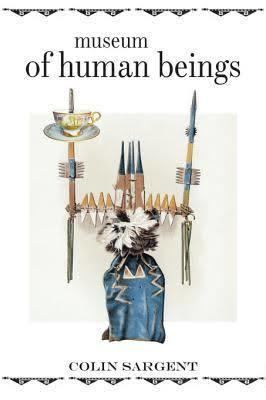8 /10 1 Votes8
5/5 Barnes & Noble | 3/5 Goodreads Originally published 2004 | |||||||||||||||||||||||||||||||||
 | ||||||||||||||||||||||||||||||||||
Museum of Human Beings, included in the National American Indian Heritage Month Booklist, November 2012 and 2013 is a novel written by Colin Sargent, which delves into the heart-rending life of Jean-Baptiste Charbonneau, the son of Sacagawea. Sacagawea was the Native American guide, who at 16 led the Lewis and Clark expedition.
Contents
Summary
At the turn of the nineteenth century, the young Indian woman Sacagawea leads Lewis and Clark to the Pacific. But what about that tiny infant in the commemorative engraving, perched on Sacagawea’s back? He is her son, Jean-Baptiste Charbonneau, the youngest member of the Expedition, a child caught between two worlds who grows into a man haunted by the mother he barely knew and the wilderness she betrayed. Sacagawea is only sixteen when she leads the Expedition and catches the eye of William Clark who finds her exotically appealing. Afterwards, Clark takes in Sacagawea and her child, and raises Baptiste as a foster son. When the teenage Baptiste attracts the notice of the visiting Duke Paul, Prince of Wurttemberg, Clark approves of the duke’s “experiment” to educate the boy at court. A gleeful Duke Paul exhibits Baptiste throughout Europe as a “half gentleman-half animal.” Eventually Jean Baptiste turns his back on the Old World and returns to the New, determined to find his true place there. He travels deep into the heart of the American wilderness, and into the depths of his mother’s soul, on an epic quest for identity that brings sacrifice, loss, and the distant promise of redemption.
Reviews
The expedition papoose Charbonneau appears on the front of the Sacagawea gold one-dollar coin (2000 to 2008) and remains in circulation in the United States today.
Calling the story “heart-wrenching,” Smithsonian Institution has recognized the work of fiction with a publication reading at the Smithsonian’s National Museum of the American Indian in Washington, D.C.
Described by publisher McBooks Press of Ithaca, New York, as “haunting,” the novel tracks the young man’s descent into deepest, darkest civilization in a search for his place in the world: At the turn of the nineteenth century, the young Indian woman Sacagawea leads Lewis and Clark to the Pacific Ocean. But what about that tiny infant in the commemorative engraving, perched on Sacagawea’s back? He is her son, Jean-Baptiste Charbonneau, the youngest member of the Expedition, a child caught between two worlds who grows into a man haunted by the mother he barely knew and the wilderness she betrayed.
“Sacagawea is only sixteen when she leads the Expedition and catches the eye of William Clark who finds her exotically appealing. Afterwards, Clark takes in Sacagawea and her child, and raises Baptiste as a foster son. When the teenage Baptiste attracts the notice of the visiting Duke Paul, Prince of Wurttemberg, Clark approves of the duke’s ‘experiment’ to educate the boy at court. A gleeful Duke Paul exhibits Baptiste throughout Europe as a ‘half gentleman-half animal.’ Eventually Jean Baptiste turns his back on the Old World and returns to the New, determined to find his true place there. He travels deep into the heart of the American wilderness, and into the depths of his mother’s soul, on an epic quest for identity that brings sacrifice, loss, and the distant promise of redemption.”
Duke Paul of Wurttemberg’s journal Erste Reise nach dem nordlichen Amerika in den Jahren 1822-1824, translated by W. Robert Nitske and edited by Savoie Lottinville as Travels in North America, 1822-1824, includes individual entries documenting the botanist nobleman's taking the precocious young Charbonneau, whom Clark had adopted and educated in St Louis, to Germany with him with the promise of further education, departing New Orleans aboard the brig Smyrna in January 1824. Adept at languages including Mandan, French, Latin, English, German, and Spanish, the young Charbonneau spent over five years at court. In the novel, young Baptiste travels across the Levant with Duke Paul and the prince’s painting companion Vogelweide, and performs piano in the presence of Beethoven.
According to Publishers Weekly:
“Playwright Sargent’s debut novel is a stylish look at the fate of Sacagawea’s baby son, Jean Baptiste Charbonneau, the first Native American to tour Europe—as a curiosity and entertainment, of course. Twenty-four-year-old Sacagawea, though married, becomes William Clark’s lover while helping guide the Lewis and Clark Expedition; after she dies on the trail, Clark adopts her son, Baptiste. Soon, Clark establishes his home in St. Louis, as well as a garish museum dedicated to his expedition, and sets to educating his new son. Soon, Baptiste is traveling Europe under the protection of Duke Paul, a cruel man who, when he isn’t exhibiting the boy to royal courts, repeatedly rapes young Baptiste. Six years later, Baptiste returns to America (astonishingly, still accompanied by Paul), where he confronts Clark over his mother’s mysterious death; unsatisfied and restless, Baptiste heads west and finds work as a fur trapper, an Army scout and gold prospector. Increasingly haunted by his mother, Baptiste revisits her in memories and visions that lend themselves nicely to Sargent’s lyrical prose. With historical cameos (Beethoven, Kit Carson, Washington Irving) and an impressively rounded portrait of the laid-back, introspective, nomadic Baptiste, this novel will satisfy fans of American history.
